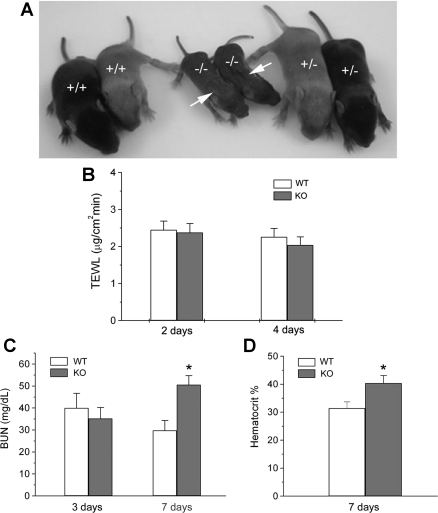Fig. 7.
Cln7−/− mice display chronic dehydration. A: 1-wk-old Cln7+/+, Cln7−/−, and Cln7+/− pups from the same litter were shown here. There were a total of 8 mice in this litter with two Cln7+/+, four Cln7+/− (only 2 were shown), and two Cln7−/− mice. Arrows indicate the wrinkled skin on Cln7−/− mice. B: transepidermal water loss (TEWL) measurement. Epidermal water evaporation was measured on the skin of 2- and 4-day-old Cln7+/+ and Cln7−/− mice. At least 7 mice were used for each group with multiple measurements for each mouse. There is no statistical difference in TEWL between two groups (P > 0.05). C: increased blood urea nitrogen (BUN) level in 7-day-old Cln7−/− mice. Whole blood was collected from 3- and 7-day-old Cln7+/+ and Cln7−/− mice. Serum was obtained by centrifuging whole blood at 2,600 g for 10 min at 4°C. BUN was measured by a Clinical Chemistry Analyzer. D: increased hematocrit level in 7-day-old Cln7−/− mice. The hematocrit measurements for Cln7+/+ and Cln7−/− mice were performed using whole blood in the presence of EDTA to prevent blood clotting. Data are represented as means ± SE (N = 6 for each group). *Value is significantly different from the WT control (P < 0.05).

